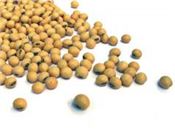|
Plant Breeder Boosts Soybean Diversity, Develops Soybean Rust-Resistant Plant

URBANA, ILL.
It took decades of painstaking work, but research geneticist Ram Singh managed to cross a popular soybean variety (“Dwight” Glycine max) with a related wild perennial plant that grows like a weed in Australia, producing the first fertile soybean plants that are resistant to soybean rust, soybean cyst nematode, and other pathogens of soy.
Singh works in the Soybean/Maize Germplasm, Pathology and Genetics Research unit in the department of crop sciences at the University of Illinois at Urbana-Champaign. The unit is a division of the U.S. Department of Agriculture’s Agricultural Research Program.
His efforts to introduce the desirable attributes of wild, perennial Glycine species into soybean plants began at the U of I in 1983 and followed a path that involved thousands of experiments, the development of a hormone treatment that “rescued” immature hybrid seeds from sterility, and multiple back-crosses of hybrid plants with their “recurrent parent,” Dwight.
Singh’s collaborator, Randall Nelson, the research leader of the ARS soybean/maize research unit, plants seeds from Singh’s most promising experiments, grows the plants and distributes their seeds to other scientists, who screen them for desirable traits and conduct their own breeding experiments.
A report of this work appears in the journal Theoretical and Applied Genetics.
Soybean is the second-most-planted field crop in the United States after corn, worth more than $4 billion annually. Current soybean varieties are susceptible to an array of pests and pathogens. Among them, the parasitic roundworm known as soybean cyst nematode attacks soybean roots and stunts their growth. Soybean rust, a fungus first detected in the United States in 2004, taints leaves and eventually defoliates the plants.
Scientists have known for decades that some wild, perennial soybean relatives had desirable traits that many hoped to introduce into soy, Singh said.
“There are 26 wild species of Glycine perennials that grow in Australia,” he said. One species, Glycine tomentella, was of particular interest because it has genes for resistance to soybean rust and to soybean cyst nematode, he said. “Many people tried to hybridize it with soybean plants, starting back in 1979 at the University of Illinois.” But the hybrids produced only sterile plants, “and they decided it was impossible,” Singh said.
He continued to experiment, however, and eventually developed a hormone treatment that interrupted the process that caused the hybrid seeds to abort. He also developed a tissue culture method for producing several embryos – and thus, several plants – from each seed. The plants were grown in a greenhouse, allowed to flower and crossed again with Dwight.
Singh eventually settled on a Glycine tomentella plant known as PI 441001 for these experiments because the wild plant was immune to soybean rust and to soybean cyst nematode. It also was resistant to Phytophthora root rot and could tolerate salt and drought.
As the experiments continued, Singh noted that each generation of hybrids had different numbers of chromosomes, reflecting their blend of soybean and tomentella chromosomes. The goal, said Singh, was to isolate each of tomentella’s 39 chromosomes, adding one at a time to soybean’s 20 pairs of chromosomes. That way, all the genetic richness of tomentella could be captured in the hybrid soybean plants.
Further crosses have introduced the tomentella genes into those of the soybean plants, creating soybean plants with 40 chromosomes and some of the most desirable tomentella traits.
So far, the effort has yielded plants that are resistant to soybean rust, soybean cyst nematode or Phytophthora root rot. Some of the new plants produce more soybeans per plant than Dwight, and some have higher protein content than Dwight.
The research continues. As a result, soybean breeders now have access to dozens of new soybean lineages, each with some of the traits of the wild Australian plants.
The genetic material in wild Glycine species “is just like a treasure that is locked inside,” Singh said. “With this method, we are unlocking the treasure.” ∆
|
|